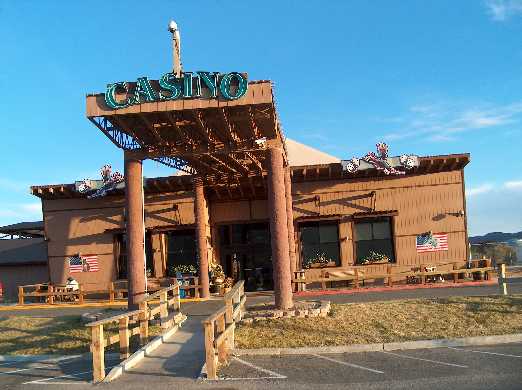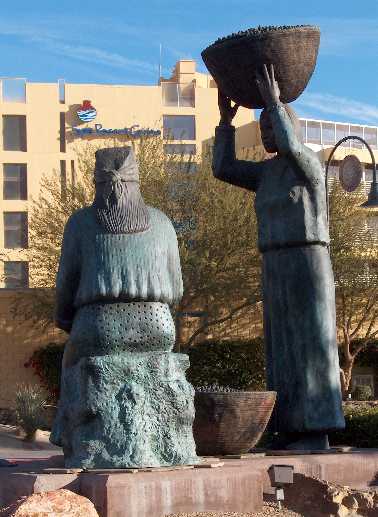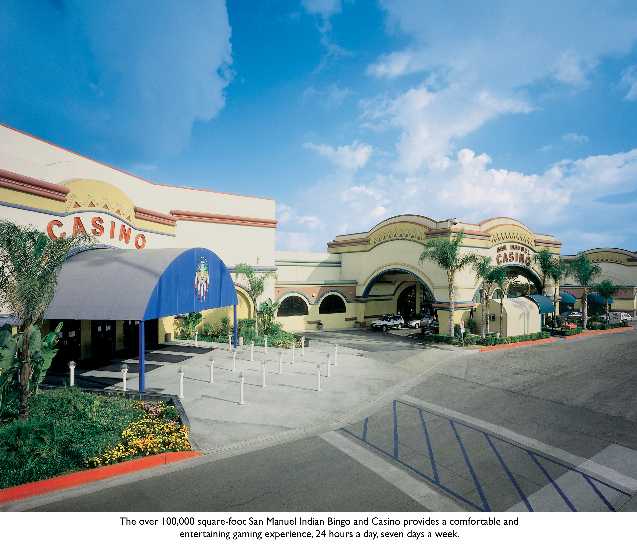 Another Stereotype of the Month entry:
Another Stereotype of the Month entry:
 Another Stereotype of the Month entry:
Another Stereotype of the Month entry:
From the Wall Street Journal:
Roll of the Dice
As Indian Casinos Grow, Regulation Raises Concerns
Major Expansion in California Would Aid State Revenue, Boost Oversight Only a Bit
'Money Stored in a Trash Can'
By JOHN R. EMSHWILLER and CHRISTINA BINKLEY
Staff Reporters of THE WALL STREET JOURNAL
August 23, 2004; Page A1
Candace Cates saw many things that troubled her as an investigator of Indian casinos for the California attorney general's office. What troubled her most was what she couldn't see.
Ms. Cates ran across what she and other agents suspected was evidence of embezzlement, kickbacks and suspicious money movements, including $90,000 being stuffed into a shoebox and driven away from one casino in the trunk of a car. Yet, she contends, her bosses at the state consistently stopped her from investigating these matters and ordered her to delete references to them from reports. One senior state official allegedly told her that because Indian tribes are semi-sovereign entities under federal law, investigators needed to "kiss a- on the reservations."
Gambling in Indian casinos is an increasingly large part of the gaming industry in the U.S. Indian casino revenues have nearly doubled since 1998, as new casinos have opened, putting the tribal sector on track to overtake the non-Indian sector within four years. But casino regulation hasn't kept pace with the growth, tribal-gambling critics say.
They maintain that Indian casinos are regulated much more loosely than their counterparts in places like Las Vegas and Atlantic City, N.J. Under federal law, the tribes that own casinos have the main responsibility for regulating them, a deal akin to letting the Yankees umpire their own games. States and the federal government play a limited role.
Evidence hasn't surfaced at Indian casinos of the kind of widespread corruption or organized-crime influence that long plagued Las Vegas. But state and federal investigators have at different times raised questions about suspected improprieties at tribal casinos in Connecticut, New Mexico and elsewhere, some of which have produced enforcement actions. Nationwide, the potential for problems is likely to grow as the industry continues to boom. More than 350 Indian casinos operate in 30 states, and dozens more are in the works.
Concerns about limited regulation are particularly acute in California. It's home to the nation's biggest Indian casino presence, and that is now on the brink of another major expansion. In an effort to reduce the state's multibillion-dollar budget deficit, Gov. Arnold Schwarzenegger is trying to get more money from California's more than 50 tribal casinos. Since June, he has signed agreements with 10 tribes that allow a dramatic expansion in casino operations and reinforce the Indians' monopoly on full-scale gambling in California. The latest deals were announced last week, including allowing the first casino to be opened in an urban area, near Oakland.
In return for the expanded casino rights, the tribes pledged $1 billion upfront to the state coffers and perhaps hundreds of millions more annually down the road. The tribes also agreed to some additional regulatory controls, including expanded rights for organized labor, audits of certain slot-machine payouts and arbitration of patron disputes.
The question is whether a few additional regulatory checks will be enough to ensure the integrity of gambling at Indian casinos where neither the state nor the federal government has much clout. The expansion will add thousands of slot machines around the state — adding to existing concerns about the accuracy of promised payouts, the adequacy of background checks for executives and a regulatory setup rife with conflicts of interest.
The current scheme of state regulation was attacked in an employment-discrimination suit filed late last year in San Diego state court by Ms. Cates and three colleagues from the attorney general's gambling-control division against their employer. In the suit, the plaintiffs laid out their suspicions of misdeeds at the casinos and claims of muzzling by state officials. The four contend their bosses punished them when they "attempted to investigate corruption in the Indian Gaming Casinos." They say they were denied promotions and otherwise punished because of their aggressive efforts at investigations. The suit is pending.
A spokesman for Attorney General Bill Lockyer denies the allegations. He notes that under federal law, which has given Indian tribes nationally a semi-sovereign status, states have only limited powers to regulate tribal gaming. This situation "requires different tactics to be used," the spokesman says, ones that have caused "a lot of frustration" to investigators such as Ms. Cates. However, he adds, the attorney general's office pursues any violation of state law that it comes across involving Indian casinos.

Bigger Cut
Most tribes are secretive about their casinos' finances, but in a few cases where returns are public, such as Foxwoods in Connecticut and Thunder Valley in California, the figures show that some casinos bring in more money than many giant Las Vegas gambling palaces. Gross profit margins at Indian casinos average 40% of revenue, compared with about 25% at commercial casinos, according to Standard & Poor's.
Tribal casino officials say they believe they're doing a good job keeping their operations clean. Mark Van Norman of the National Indian Gaming Association, a trade group, says a network of tribal, federal and state overseers provides "a strong framework" for regulation. He estimates that tribes nationally spend $200 million a year and employ more than 2,000 people to regulate their casinos.
The U.S. role in the Indian casino industry was set out in a 1988 law creating a federal oversight body called the National Indian Gaming Commission, or NIGC. Some view this as much a helper as a watchdog. "One of its prime functions is to assist the tribes in making money," said Charles Lombardo, a senior vice president of the Seminole tribe's casinos in Florida, during an investor conference call in May.
A spokesman for the NIGC says it views itself as a regulatory agency. However, he adds, "we don't see profitability and regulation as necessarily being at odds. We see good regulation as actually, in the long run, adding to the bottom line."
The NIGC — a federal regulatory body totally financed by fees from the industry it oversees — has a staff of 79 and plans to spend about $11 million this year. By contrast, New Jersey, with 12 Atlantic City casinos, has a staff of 700 and a $60 million budget to oversee gaming activities in the state.
Last year, the NIGC issued eight enforcement actions for such things as failing to submit required reports. The NIGC spokesman says the agency also resolved about two dozen violation probes informally. Nevada, whose casinos produce two-thirds the revenue of the nation's tribal casinos, convicted some 380 people of gambling-law violations.
States, too, have only a limited say in tribal gambling affairs. Under the 1988 federal law, tribes wanting to offer full Las Vegas-style gambling — with slots and table games — had to reach an agreement, known as a "compact," with their home state.
While compacts vary by state, more than four dozen in place in California have been criticized by enforcement officials and others as loosely written and vague. For instance, while they contain revenue-sharing agreements, they don't clearly define how to calculate revenue. Tribes have come up with various methods for doing so. State investigators are limited in how deeply they can scrutinize certain aspects of casino operations.
A key example involves perhaps a pressing question to any gambler: What are the chances of winning? Tribes say their slot machines pay out as much as those in Vegas. In Nevada and in other states, regulators make casinos prove their machines pay as much as promised and send inspectors to check them. In California, checking is left to the tribes.
A document uncovered by the Ukiah, Calif., Daily Journal last year showed that the February 2003 slot payout at the nearby Sho Ka Wah casino hovered near 70% of what gamblers bet — far below the 95% average at Las Vegas casinos. Sho Ka Wah officials didn't return calls for comment. Managers at three other California tribal casinos say their payouts are higher but won't share their data.
The state's regulatory structure is an "honor system ... which is nuts," says I. Nelson Rose, a member of California's Gaming Policy Advisory Committee, which advises California regulators.
"Why isn't the state aggressively enforcing the compacts?" asks David Ronquillo, lawyer for plaintiffs in the Cates suit. His answer: "Politics and money." Indian tribes have given Attorney General Lockyer, ultimate boss of the Cates-case plaintiffs, several hundred thousand dollars in campaign donations in recent years. The attorney general's spokesman says tribal contributions don't affect how Mr. Lockyer carries out his duties.
Peter Melnicoe believes his attempt to create a set of statewide standards for tribal casinos got him fired as general counsel for the California Gambling Commission, a state board that oversees gambling but relies on the attorney general's office to do investigations. Mr. Melnicoe says he was fired earlier this year without explanation after three years in the job. A spokeswoman for the commission says the dismissal wasn't due to any tribal pressure. She declines to elaborate, saying the commission doesn't discuss personnel matters.
Gov. Schwarzenegger's renegotiation of compacts certainly raised money for the state. Last year, California collected just $95 million from tribal casinos — out of the casinos' total revenue of roughly $5 billion — and gave most of that to tribes without casinos for social programs. Connecticut, which has stricter rules, requires tribes running the giant Foxwoods and Mohegan Sun casinos to pay the state 25% of their net winnings, which amounted to $390 million last year.
California's new agreements with 10 tribes are more lucrative, ultimately worth a total of as much as $400 million a year for the state. In the short term, California will get $1 billion from five of the tribes as an advance on the state's share of future revenues. But the revised compacts don't deal with a range of concerns regarding regulation. The state's tribal casinos won't have to make public any financial data, for example.

On Background
Background checks have been a key part of casino regulation nationally ever since the 1970s crackdown on the mob in Las Vegas. At commercial casinos, the licensing of senior executives can take a year and include painstaking reviews of their past.
Glenn Christenson, chief financial officer of Las Vegas-based Station Casinos Inc., has undergone licensing inquiries in Nevada and Missouri as well as by tribal regulators in California, where his company manages Thunder Valley Indian casino. Nevada regulators "really have looked at every check" he's written for years past, says Mr. Christenson. "In Missouri, they came to Nevada and knocked on our neighbors' doors."
California tribal regulators? "They came in and checked some things" but the effort wasn't nearly as extensive, he says. Thunder Valley general manager Scott Garawitz maintains the casino's review is extensive, saying he faced a criminal background check and drug testing.
The Cates lawsuit says one investigator, looking at an Indian casino called the Trump 29 near Palm Springs, Calif., found that the tribe hadn't checked the background of three former members of the tribal casino regulatory commission and that one of them had an outstanding arrest warrant for assault with a deadly weapon. (Trump Hotels & Casino Resorts Inc. manages the casino for the tribe.) For part of the past decade, the regulatory commission was headed by Dean Mike — who simultaneously was chairman of the casino's owner, Twenty Nine Palms Band of Mission Indians.
Gary Kovall, an attorney for the tribe, defends Mr. Mike's dual role, noting that like many tribes, the Twenty Nine Palms band is small, with fewer than 20 members. But the tribe "realized there was a perception of possible lack of objectivity" by Mr. Mike, so it appointed a four-member commission that includes no tribal member, Mr. Kovall says.
He disputes the lawsuit claims, saying the tribe does background checks. As for the assault charges against the former commissioner, they were dismissed last year by a state court, he adds. Mr. Trump says he isn't aware of any regulatory problems at the casino. He calls Mr. Mike "a fine guy."
What helped crystallize Candace Cates' concerns about regulation was what she saw at the Valley View casino in San Diego County, owned by the San Pasqual Indian band. It's is a low-slung, smoky cave of a place filled with the high-decibel racket of 1,200 slot machines.
During a 2001 inspection, Ms. Cates saw "large amounts of money stored in a trash can" at a small booth near the front entrance, her lawsuit says. She later viewed a casino surveillance tape that allegedly showed a woman from the booth putting $90,000 into a shoebox, placing the box into her car's trunk and driving off. Ms. Cates wanted to take the information to the local district attorney, the suit says, but her supervisor told her to discontinue her probe and "not to discuss the investigation with anyone; no reports were to be prepared."
The suit says that a year later, someone at the casino asked Ms. Cates to investigate "alleged accounting improprieties by casino employees and the theft of casino funds." Again, she was allegedly blocked by her superiors, who maintained this position even after an informant contacted her about having received "threats of physical harm for having disclosed the alleged embezzlement to a state gaming agent."
The booth where she says she saw money in a trash can is operated by a vendor, Money Centers of America Inc., which provides check-cashing and other services to gamblers. Christopher Wolfington, chairman of Money Centers parent company iGames Entertainment Inc., says money was never stored in a trash can. He acknowledges that cash was moved in an employee's car on occasion. The money went either to the bank or to a Money Centers' cash booth at a nearby Indian casino, he says, adding that he showed records of each of those transactions to the National Indian Gaming Commission and other regulators. The location was remote and it could be hard to get armored-car service, he says. But now he says the firm moves all money by armored car.
In Las Vegas, cash never leaves the purview of armed guards, armored cars and a complex system of checks. In New Jersey, state regulators keep offices on the casino property and have access to all cash-handling operations.
The California attorney general's spokesman says the Valley View matter was investigated by federal regulators, who "asserted jurisdiction." The tribal gaming commission and the NIGC looked into the cash movements at Valley View. Neither took disciplinary action. The NIGC spokesman says the commission investigated the matter and "was satisfied that there was no misappropriation of funds or criminal activity."
Ulysses Belardes, a member of the Valley View gambling commission, says, "It was just a poor way of transporting money."

NIGA replies
From the Wall Street Journal:
Indian Gaming Covered by Three Governments
September 1, 2004; Page A13
Your Aug. 23 article "As Indian Casinos Grow, Regulation Raises Concerns" omitted important information.
While the writers acknowledge that tribal governments "spend $200 million a year and employ more than 2,000 people to regulate their casinos," two paragraphs later they discount these numbers. They compare Indian gaming, using only the numbers for the federal National Indian Gaming Commission (NIGC) — "a staff of 79 and . . . $11 million" — to New Jersey's gaming regulation — "a staff of 700 and a $60 million budget." They also omit facts that we provided in an interview: In addition to the $200-plus million that the tribes spend on regulation, they reimburse the state's $50 million annually for regulation. Add the $11 million for the NIGC, and the total is over $260 million annually, and over 2,700 regulatory personnel for 350 operations. These numbers, when counted correctly, blow New Jersey's regulation away. Also, compare tribal regulation to the more than 2,000 gaming operations in Nevada — regulated by the state's $27 million budget and 430 employees.
Indian gaming is regulated by three governments: Tribal, federal and state. In addition to the NIGC, the tribes work with the Department of Justice's FBI, Treasury's IRS and Financial Crimes Enforcement Network, and the Bureau of Indian Affairs within Interior. Because of this comprehensive web of regulation, federal agencies have consistently reported that the tribal regulatory system is working to protect the integrity of the games and to shield Indian gaming from corruption. Conversely, state lotteries, commercial casinos and race tracks have consistently fought the establishment of a federal regulatory body, and currently answer to no federal regulatory agency despite constant reports of regulatory concerns. Talk about umpiring your own game.
Ernest Stevens Jr.
Chairman
National Indian Gaming Association
Washington
Rob's reply
This article tries to paint Indian gaming as dangerously unregulated, but fails to provide much evidence. Ernie Stevens blew away the argument that tribal casinos are less regulated than Nevada or New Jersey casinos. Other points worth mentioning:
The article claims that "Under federal law, the tribes that own casinos have the main responsibility for regulating them, a deal akin to letting the Yankees umpire their own games." Self-regulation is the standard, not an exception. Every business and government in the world relies on its own accounting controls first and external regulation second.
If the WSJ wants to use a baseball analogy, a better one would be with the league as a whole. Baseball teams and umpires report independently to MLB just as a tribal casino and tribal regulators report independently to the tribal council. The umpires don't report to the teams they umpire and the regulators don't report to the casinos they regulate, although both ultimately report to the same authority.
The article states: "Evidence hasn't surfaced at Indian casinos of the kind of widespread corruption or organized-crime influence that long plagued Las Vegas. But state and federal investigators have at different times raised questions about suspected improprieties at tribal casinos in Connecticut, New Mexico and elsewhere, some of which have produced enforcement actions." Talk about burying the lede.
Let's reiterate these points, since they're key to why this article stereotypes Indian gaming. No evidence of crime or corruption at Indian casinos. When questions were raised, the tribes answered them or enforcement actions resolved them. Message: Indian gaming regulation is doing the job.
This article seems to be built upon Candace Cates' complaints. Again, the story buries the facts. Two regulatory bodies—the tribal gaming commission and the NIGC—"looked into the cash movements at Valley View. Neither took disciplinary action"—because the trash-can incident never happened, so there was nothing to discipline. The NIGC "was satisfied that there was no misappropriation of funds or criminal activity."
Moreover, Valley View has changed its procedures since Cates reported its sloppy money-handling in 2001. To sum it up: Problem arose...regulators intervened...casino changed practices...problem solved before a financial loss could occur. That's exactly how regulation is supposed to work.

Also worth noting is that I. Nelson Rose is a known opponent of Indian gaming. And although the WSJ interviewed NIGA, the newspaper didn't include any of NIGA's comments. Can you say "bias"?
Although the WSJ qualified nearly all its comments, it did so weakly, after presenting a litany of charges. The article wasn't a "fair and balanced" look at regulation. Rather, it clearly tried to slant the case against Indian gaming.
Related links
The facts about Indian gaming
|
. . . |

|
All material © copyright its original owners, except where noted.
Original text and pictures © copyright 2007 by Robert Schmidt.
Copyrighted material is posted under the Fair Use provision of the Copyright Act,
which allows copying for nonprofit educational uses including criticism and commentary.
Comments sent to the publisher become the property of Blue Corn Comics
and may be used in other postings without permission.